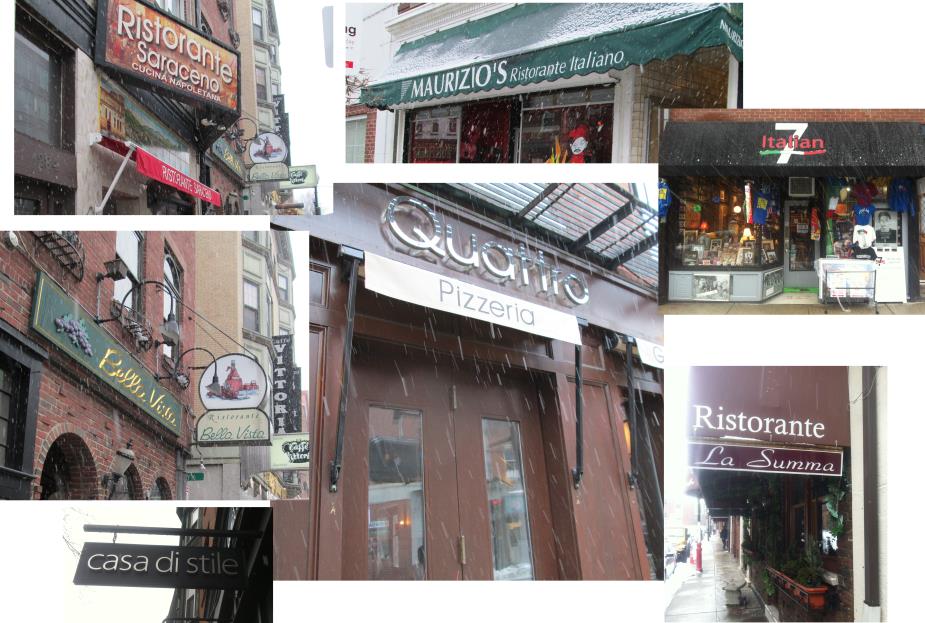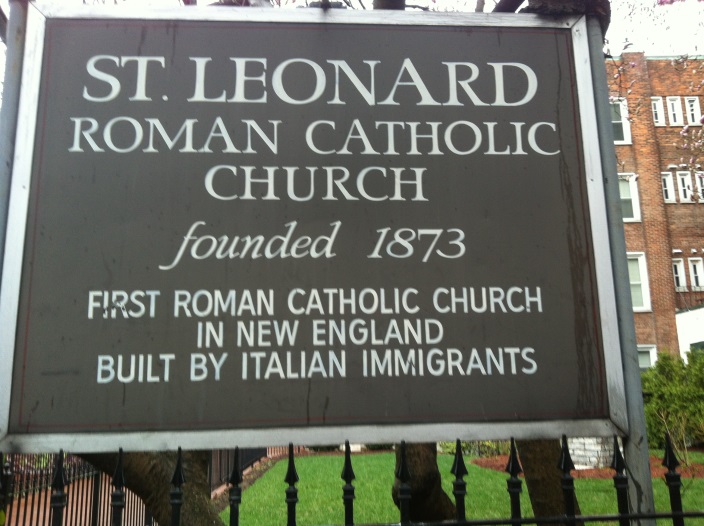The site I have selected for my project lies in the North End, a neighborhood in Boston that is very well known for its vast historical legacy as well as the huge Italian influence that affects it at the current time. There are a number of things I find interesting and intriguing about the North End, the aforementioned being the most obvious ones. With its rich history and its cultural diversity, I believe the North End is fascinating neighborhood with many stories to tell and mysteries to solve.
 The North End exhibits a very obvious break line formed by I-93 which gives it away as a place that developed before its surroundings.
The North End exhibits a very obvious break line formed by I-93 which gives it away as a place that developed before its surroundings."Boston, MA." Google Maps. Google, 6 March 2014. Web. Accessed 7 March 2014.
In his book How to read the American city, Grady Clay defines breaks as a form in the streets layout where one grid intercepts another one, creating and awkwardly placed diagonal separation between them (42). Breaks, Grady explains, are particularly interesting locations because they tell us about development from two places that started at different times but ended up intercepting each other. I found this idea quite fascinating and grew quite fond of it, which is one of the reasons that first called my attention towards the north end, which features a very obvious break line, immediately suggesting that it was once its own settlement long before its immediate surroundings started developing.
The particular zone that I have chosen as my site originates around one of the most symbolic places of the North End, the Paul Revere mall, and I extended my boundaries a little further back to Salem Street just to include the historical Old North Church. Finally, I extended my site down Hanover Street, which is the main street running through the North End to include one last place of interest: St. Leonard's Church. The result was a site with an almost regular shape bounded by four streets: Hanover, Salem, Prince, and Charter.
 "Boston, MA." Google Maps. Google, 6 March 2014. Web. Accessed 7 March 2014.
"Boston, MA." Google Maps. Google, 6 March 2014. Web. Accessed 7 March 2014.
 Click to enlarge.
Click to enlarge.
 The Paul Revere Mall (Photo by author)
The Paul Revere Mall (Photo by author)
The vast historical legacy of the neighborhood will without a doubt form a significant part of my analysis of the site. What influence did this settlement, with its convenient shoreline location, have during the early colonization and Revolutionary periods? What factors can we find nowadays as evidence of the heritage of those epochs and how they helped shape the site? I kept this in mind when choosing my boundaries, which I believe contain a very adequate balance of references between both the historical and cultural aspects earlier discussed. Having served as the home city to the Revolutionary hero Paul Revere, it contains several memorials to his life, including his house, which lies just outside my site boundaries, but more importantly the Paul Revere mall, a park that features a large metal statue of Revere in the center and a wide open space that undoubtedly has some stories to tell. Standing out as a large land area under a single use in a neighborhood where everything is cramped and space is limited, the question must arise; what could have lain in that large space before that was able to be cleared all at once?
 Countless Italian establishments swarm Hanover Street (photos by author).
Countless Italian establishments swarm Hanover Street (photos by author).
Culturally speaking, the North End is just as rich in terms of artifacts that reveal its past. In particular, the Italian influence on the North End becomes immediately obvious as soon as one enters the neighborhood. Walking down Hanover Street, which contains the main commercial area of the zone, one can spot countless establishments advertising their Italian roots, the most prominent ones being of course restaurants, which fill the air in the North End with the very distinctive scent of Italian food. The North End is today known as a “little Italy”, and it was this neighborhood in – and it alone – that became so popular for Italian immigrants, so the question must arise; what exactly was it that attracted this particular ethnic group to this particular site? The answer to this question will be of great interest towards the understanding of the site’s structure, since it can be very easily seen that his influence has played decisive roles in shaping the neighborhood.

The Italian culture influence in the site is further made evident by the existence of a handful of churches dedicated to Italian saints. Although most of these were located further north, next to the shore over Commerce Street, I managed to find St. Leonard's Church, which was reachable by expanding the border of my site a little south-west. I wanted to include at least one example of said type of churches, which is why I expanded my boundaries just to cover it. As it turns out, St. Leonard's Church is actually one of the most important ones of its kind, since it was the very first Italian Church built in Boston, as proudly advertised by its entrance sign. It also contains a small garden with several stone statues of saints, known as the St. Leonard's peace garden.
All in all, I believe North End provides a very adequate field for developing my project. There are several questions that arise immediately as well as some interesting observations here presented, which I believe illustrate the North End as a very interesting site with a lot of space of exploration and investigation, particularly in the historical and cultural aspects. As this semester goes on, I hope to get more and more familiar with the site and to be able to answer my many questions regarding it.